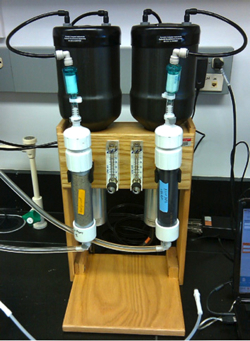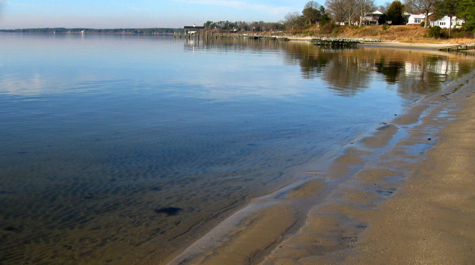Research sheds light on importance of submarine groundwater
Residents of the Chesapeake Bay watershed are likely to be very familiar with the streams and rivers that feed the Bay, whether it’s from swimming, boating, driving across a bridge or through a tunnel, or simply enjoying a sunset.
But there are other, unseen, sources of water that affect the Bay and coastal ocean—flows of underground water that according to new research may play a bigger role in marine ecosystems than previously thought.
Professor Aaron Beck of the Virginia Institute of Marine Science is studying this groundwater—and the nutrients and pollutants it carries. He’s doing so with a cutting-edge technique that uses trace amounts of naturally occurring radioactive isotopes. Beck is a geochemist who arrived in Gloucester Point in 2009 as the newest member of the VIMS faculty.
Groundwater versus river flow
Scientists have long known that groundwater makes a small but important contribution to estuaries and the coastal ocean. “Russian hydrologists have been working on this problem for the past 50 to 60 years,” says Beck. “They’ve tried to figure out how much groundwater is going directly from the land into the sea, instead of going from the land into rivers and then into the sea.”
It turns out the answer is “not much.” Beck says groundwater contributes only 5 to 10 percent as much to the ocean as does river discharge. But he cites several journal articles, including a landmark 1993 paper by VIMS professor John Milliman, showing that groundwater can have a disproportionate impact, due to the heavy load of chemicals and pollutants it picks up during its passage through rocks and sediments.
Milliman, for example, estimated that global groundwater discharge is only about 6% of river flow, but contains such a high concentration of calcium carbonate that it provides almost half of the ocean’s reservoir of this mineral, which is important to corals, shellfish, and other ocean creatures that use it build their skeleton. Milliman argued that groundwater had an even bigger impact on ocean chemistry during past ice ages.
Submarine groundwater discharge
Beck is now taking these earlier studies one step deeper, moving beyond the groundwater that flows from land to sea to look at “submarine groundwater”—seawater that moves from the water column into the seafloor and back out again.
Because this water is already in the ocean, its transfer between the water column and seafloor sediments has no effect on ocean volume. But it does have a significant effect on ocean chemistry.
“Submarine groundwater isn’t important for water balances, but it’s really important for chemical balances,” says Beck. “The most important thing is that even though it’s re-circulated seawater, when you put it into the sands the chemistry changes, so that when you bring it back out it’s completely different than it was when it went in.” The transformation reflects the cycling of nutrients and metals, the diffusion of oxygen between water and sediments, and the effects of bottom-dwelling worms, shellfish, and algae.
Beck's preliminary results from a study of the VIMS shoreline confirm earlier studies, suggesting that the amount of nitrogen released by submarine groundwater can be large—equal to or exceeding that supplied by local rivers.
He notes that most of this nitrogen isn’t “new,” instead being recycled from nitrogen already present in the water. But he says this recycled nitrogen can still impact Bay waters in significant ways. He compares seafloor sands to “a really active bio-filter that returns all of these nutrients back to the water column.” “It’s not a new nitrogen source,” he says, “but it certainly might contribute toward sustaining new phytoplankton growth.”
Excessive growth of algae and other phytoplankton is one of the most pressing issues facing Chesapeake Bay, giving rise to harmful algal blooms, low-oxygen “dead zones,” and other water-quality issues.
Radium studies
Beck and others study submarine groundwater using radium and other naturally occurring radioactive isotopes. The radium comes from the decay of uranium—then thorium—naturally present within sand grains. The radium atoms move into the tiny, water-filled pores between seafloor sand grains, and subsequently into the waters of the coastal ocean. The radium occurs in such minute quantities, says Beck, that it is “almost beyond detection, even with our most sensitive instruments.”

Beck is interested in radium only as a tracer that allows for study of seawater’s other chemical constituents. “You take seawater and put it into these sands and when it comes back out it’s loaded with radium,” he says. By comparing levels of radium in pore waters and seawater, and knowing the rate at which it decays, researchers can estimate the volume of submarine groundwater, gauge the time it spends as pore water, and trace its path through ecosystems. Because different radium isotopes have half-lives that range from 3.5 days to 1,600 years, the technique can be used to study both short- and long-term environmental processes.
Indeed, radium studies show that the processes responsible for forming submarine groundwater occur on widely different time scales, from the quick slap of a wave on a beach to the daily ebb and flow of tides through the Bay or the sweep of deep-sea currents across the continental shelf.
The studies also show that a host of different phenomena can drive submarine groundwater in and out of seafloor sediments. “Tidal pumping, wave set-up, thermal gradients, density overturning—all of these processes can force seawater into sands, and then back out.” Beck says “Sometimes the saltwater can penetrate very deep—several meters—sometimes it’s just occurring at the surface.”
Beck’s preliminary studies of local submarine groundwater show that it penetrates about a foot into the sands at Gloucester Point. They also show a clear signature of the daily tidal cycle at Gloucester Point and a more complicated signature at Virginia Beach that combines tidal activity and significant wave action.
Beck’s long-term goal is to refine the techniques he uses to study radium, and to use the more accurate results to further monitor and quantify the flow of nitrogen and other substances into and within the Bay.


